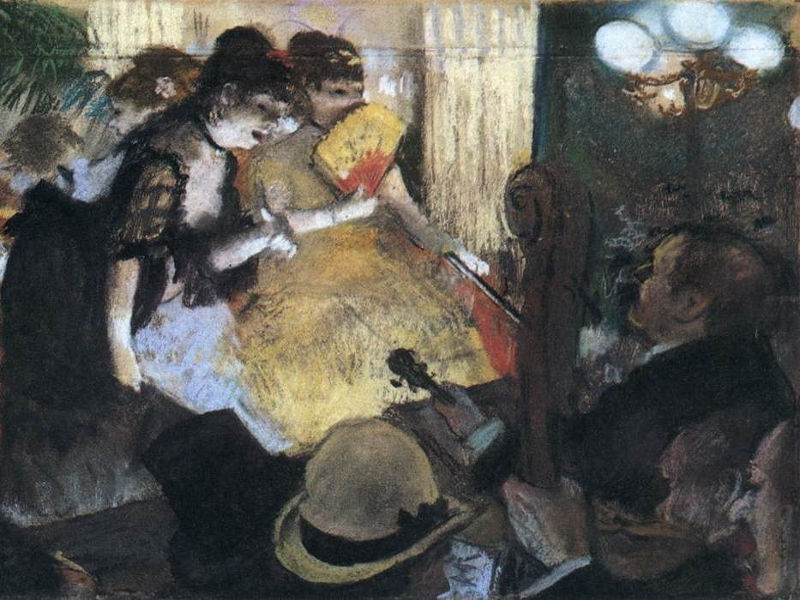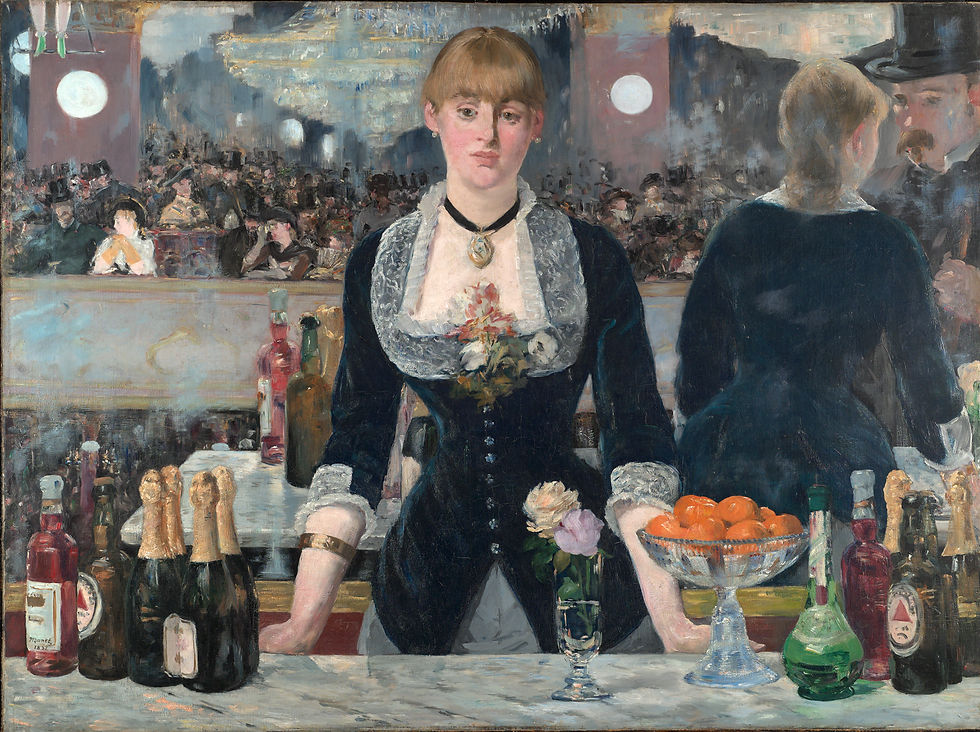With Friends | Cabarets, Dance-halls, and Ballrooms | Seduction and Love | Celebrations and Social Life | Political Life and Public Affairs
The pleasure of Cabarets, Dance-halls and Ballrooms


A BAR AT THE FOLIES-BERGÈRE (UN BAR AUX FOLIES-BERGÈRE)
Edouard Manet (1531-1575)
1881/82
Courtauld Institute, London
Edouard Manet takes us to the Folies-Bergère. The writer Joris-Karl Huysmans, an art critic known for his outspokenness, acknowledged this painting of the bar as “certainly the most modern and interesting that this Salon [the official Salon of 1882] has to offer.” A hybrid mix of café, concert and theater, the Folies-Bergère played host to a shady clientele who drank, smoked, chatted, joked and wandered continually around the venue, from hall to arcade and from bar to auditorium. The bar made available many different alcohols, including champagne, a tried-and-tested symbol of parties and pleasure.
“The fashionable people were as attached as ever to the sparkling wine that they couldn’t turn down. They were on top of the world. Eliane de Pougy, Cléo de Mérode, Caroline Otéro and Emilie d'Alençon quaffed champagne offered to them by the grands-ducs in the bar of the Folies-Bergère, hotspot of venal love.” The aspect of this painting which most attracted comment by critics was the reflection in the mirror of Suzon, an employee. The reflection is not accurate in terms of the young woman’s position or that of the man opposite her, who is standing so close that realistically he would be blocking the spectator’s view. It is hard to say whether this is on purpose or an error on the part of the artist, something which amused Huysmans. He described with delectation the manner in which the painting “stupefies visitors, who press forward and swap disorientated comments on this canvas mirage.”

TAVERN SCENE WITH A LUTE PLAYER Bartolomeo Manfredi, ca. 1621 Los Angeles County Museum of Art, Los Angeles, CA, United States / 1

MUSICIAN AND DRINKERS (REUNION DANS UN CABARET) Valentin de Boulogne, ca. 1625 - Musée du Louvre, Paris / 2

VILLAGE INN Gillis Van Tilborgh 1657/59 - The Hermitage, St. Petersburg, Russia / 3

PEASANTS CAROUSING AND DANCING OUTSIDE AN INN Adriaen Jansz. Van Ostade, 1660 - Private collection / 4

CABARET OF RAMPONNEAU (CABARET or CABARET DE RAMPONNEAU) Benjamin Eugène Fichel, 1877 - Fine Arts Museum, Bordeaux, France / 5

DANCE IN THE MOULIN LA GALETTE (BAL DU MOULIN DE LA GALETTE Auguste Renoir, 1876 - Musée d'Orsay, Paris / 6
> Click on the icons for a closer look at the artworks
1-2. The cabarets of the 16th and 17th centuries were either establishments selling “by the pot or by the pint” to passing customers, who drank standing at the bar or took their wine away; or cabarets à assiette, bars where customers ate and drank around tables. In Paris, cabaret wines were cheap, coming from the Orléans, Gâtin or Brie regions. Prostitutes, lute players, fortune tellers and pickpockets were to be found alongside courtesans and youths. Such scenes are portrayed by Bartolomeo Manfredi and Philippe de Champaigne.
3-4. In the countryside, the cabaret was a Sunday treat after a week of hard labour and self-denial: there was nothing like abandoning oneself to the various pleasures of wine, games and dancing to forget the troubles of everyday life, as Gillis Van Tilborgh et Adriaen Jansz van Ostade show. They plunge us into scenes of rural life, where any excuse for a party will do.
5. Dance-halls appeared at the gates of Paris, Lyon and Metz towards the middle of the 18th century, and multiplied wherever excise duties had become exorbitantly high. “They allowed wine to flow in the Parisian region, since merchants could not buy and import it themselves.” Au Tambour Royal, Ramponneau’s first cabaret, quickly became one of the most prized entertainment spaces in western Paris. Amateurish frescoes represented the manager as Bacchus riding a barrel, or sandwiched between ‘Love’ and ‘Glory’, with his motto, “Monoye fait tout” [“Money does all”], and the following verses: “Voyez la France accourir au tonneau, Qui sert de trône à monsieur Ramponneau” [“Watch France running to the barrel / Which serves as the throne of Monsieur Ramponneau”]. Ramponneau sold wine at three sous per pint – one sou less than his counterparts at the barrière de La Courtille – whereas any type of wine, even the most basic Orleans wine, sold for twelve to fifteen sous in Paris itself. The resulting situation was only to be expected: an extraordinary number of customers inside and out – people would even queue to go in! The painting, completed by Fichel in 1877, is a reconstruction of the glory days of the establishment, when its owner moved the premises from La Courtille to Belleville aux Pecherons. Here he repeated the exercise, this time with white wine at three to three and a half sous per pint, again outpricing his competitors, who charged four and a half. The wine was the same both times, a guinguet (from the French for ‘jig’), a pale wine from the Paris region. People would sing: “Vive le vin de Ramponneau, C’est du nectar en perce!” [“Long live the wine of Ramponneau / It’s nectar in a barrel!”]. The main room of the original restaurant, expanded in 1778, could hold 600 people – market gardeners, carters, workers... – but also female aristocrats (such as Madame de Genlis, who spoke of the dancehall in her memoirs) who came for the thrill disguised as common women. The dancehalls were a place of consumption, fun and pleasure. Dodging the taxman may well have been part of the fun!
6. The guinguettes existed in another form after the Revolution, but moved to the banks of the Seine (see Luncheon of the Boating Party by Renoir) or the Marne. One of Auguste Renoir’s most famous paintings shows the Bal du Moulin de la Galette (Musée d’Orsay). When Dutch painters such as Jan Steen and Adriaen Jansz van Ostade painted their scenes of popular rejoicing, they searched especially for ‘characteristic’ figures. With scenes of sophisticated parties, Rococo painters like Watteau and Nicolas Lancret expressed their dream of a carefree, elegant life. Renoir gives us little of either. He enjoys showing us his characters’ mannerisms and conjures up a charming celebratory atmosphere. We discover a public ball; it is Sunday afternoon and the weather is fine. A joyful crowd of people from all levels of society share in the fun, dancing on the left, chatting on the right, smoking and drinking. The atmosphere is lively and joyful and, as in Luncheon of the Boating Party, wine plays an important part.

CABARET (CAFE-CONCERT), detail Degas, 1876/77 - Corcoran Gallery of Art, Washington

THE BAR AT THE FOLIES BERGÈRE, First version Edouard Manet, 1881 - Private colection

CABARET Edvard Munch, 1885/86 - Munch Museum, Oslo, Norway

THE DANCE HALL IN ARLES Vincent Van Gogh, 1888 - Musée d'Orsay, Paris

LE TABARIN or CABARET AT PARIS Émile Bernard, 1889 - Private collection / 5

MOULIN DE LA GALETTE INTERIOR Ramon Casas, ca. 1890/91 - MNAC, Barcelona, Spain

A CORNER OF THE MOULIN DE LA GALETTE Henri de Toulouse-Lautrec, 1892 - National Gallery of Art, Washington

AT THE MOULIN ROUGE Henri de Toulouse-Lautrec, 1892/95 - Art Institute, Chicago, United States

BAL BULLIER GARDEN, AT NIGHT Ludovic Vallée, 1902 - Carnavalet Museum, Paris

LE MOULIN DE LA GALETTE Pablo Picasso, ca. 1900 - Guggenheim Museum, New York

"LE LAPIN A GILL", Sign André Gill, 1879 - Le Lapin Agile Cabaret , Paris / 11

AU LAPIN AGILE Picasso, 1905 - Metropolitan Museum of Art, New York

VAUDEVILLE THEATER (ENGLISH DANCING COUPLE) Ernst Ludwig Kirchner, ca. 19097 (1926) - Städel Museum, Francfurt, Germany

THE DANCE OF PAN-PAN AT "MONICO" (LA DANSE DU PAN-PAN AU "MONICO") G. Severini, 1909/11 | 1959/60 - Pompidou Center, Paris / 14

FRENCH-CANCAN AT TABARIN (LE FRENCH-CANCAN A TABARIN) Pierre de Belay, 1937 - Musée des Beaux-Arts, Quimper, France / 15
> Click on the icons for a closer look at the artworks
5 and 15. The Bal Tabarin was a Parisian cabaret located at the foot of the Montmartre hill. Founded in 1904, it quickly became the meeting-place of Parisian society and its artists.
11. It’s Au Lapin Agile, a cabaret situated on the Montmartre hill. Founded in the second half of the 19th century and bought by Aristide Bruant in 1913, it was one of the preferred meeting-places of artistic bohemians of the early 20th century: from Max Jacob to Pablo Picasso, passing by Roland Dorgelès, Francis Carco, Blaise Cendrars and Pierre MacOrlan.
14. The start of the 20th century marked an important step in the relationship between women and champagne: the Belle Époque. During this period, the ‘king of wines’ and the fair sex were brought together. Champagne was not drunk for its taste, or to alter one’s perceptions, but because it was the symbol of joie de vivre. A wave of female ‘champagne debauchery’ occurred among fashionable cosmopolitans in France and elsewhere. Champagne flowed in the “Monico”, where the noise was deafening, with the clatter of high heels, men’s heavy footsteps and loud music. Champagne “gave women an amazing verve”. Gino Severini’s canvas was painted from memory after the disappearance of his 1909-1911 work.
CABARETS IN MEDIEVAL ILLUMINATIONS

DRINKING WHITE WINE AT TAVERN Österreichischen Nationalbibl., Vienna, Austria

DRUNKS IN A TAVERN End of 14th cent. - British Library, London

TABLE SERVICE Histoire de Renaud de Montauban, 1470 - Arsenal Library, Paris

BANQUET WITH COURTESANS Facta et dicta memorabilia, ca. 1455 - BnF, Paris
> Click on the icons for a closer look at the artworks
A pictorial technique similar to that of frescoes or miniatures, illuminations were very popular during the Middle Ages. Done by hand, illuminations decorated or illustrated texts, namely manuscripts. Until the 12th century, manuscripts were copied out in religious settings, such as abbeys, where they were used to support prayer and meditation. From the 13th century, private artisans began to produce literature for the secular market. This was due to the growing university and administrative sectors and the emergence of a new reading public. Illuminations can give us a lot of information on the history and place of wine in Medieval society. Once more, painting plays a documentary role. The world of wine is portrayed in illuminations in much the same way as in frescoes and paintings.
Find out more: Wine in Illuminations, From Drinking to Savoir-boire >>
GALLERIES SOCIAL LIFE AND LIFE IN SOCIETY
> Wine and Painting > From Drinking to Savoir-boire > Social Life and Life in Society > Cabarets, Dance-halls, and Ballrooms






